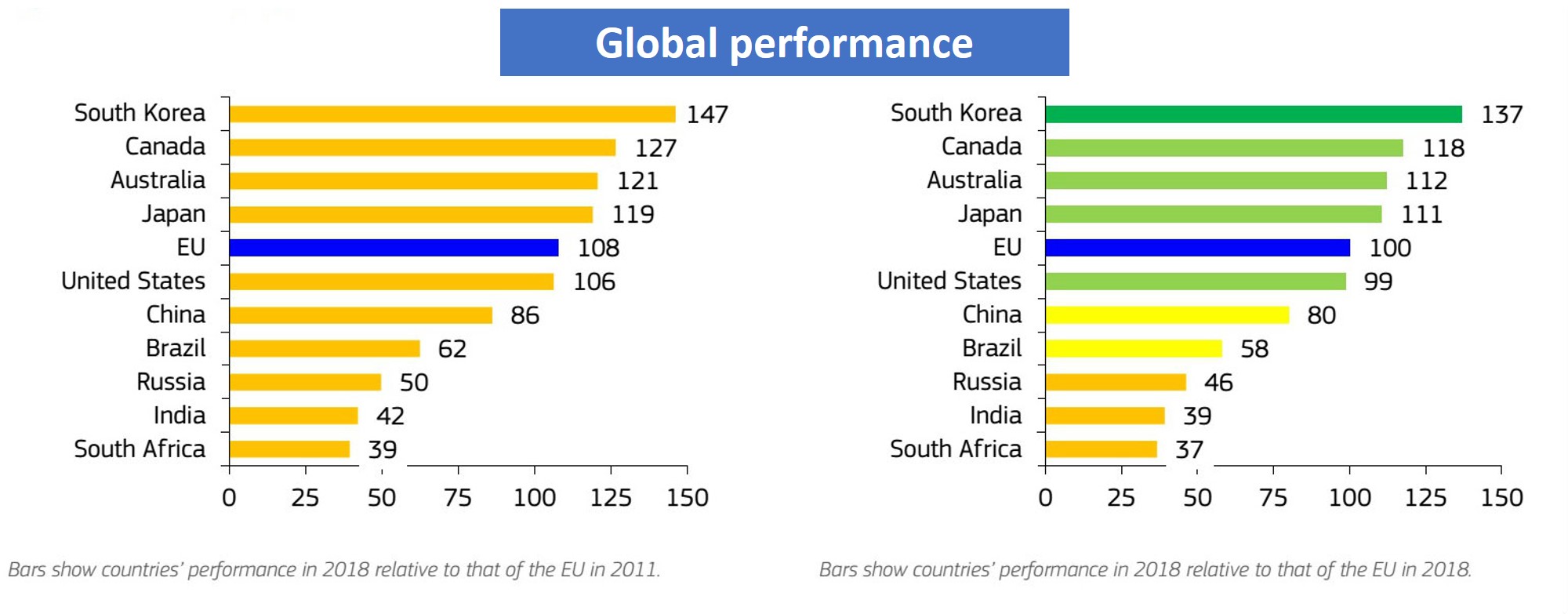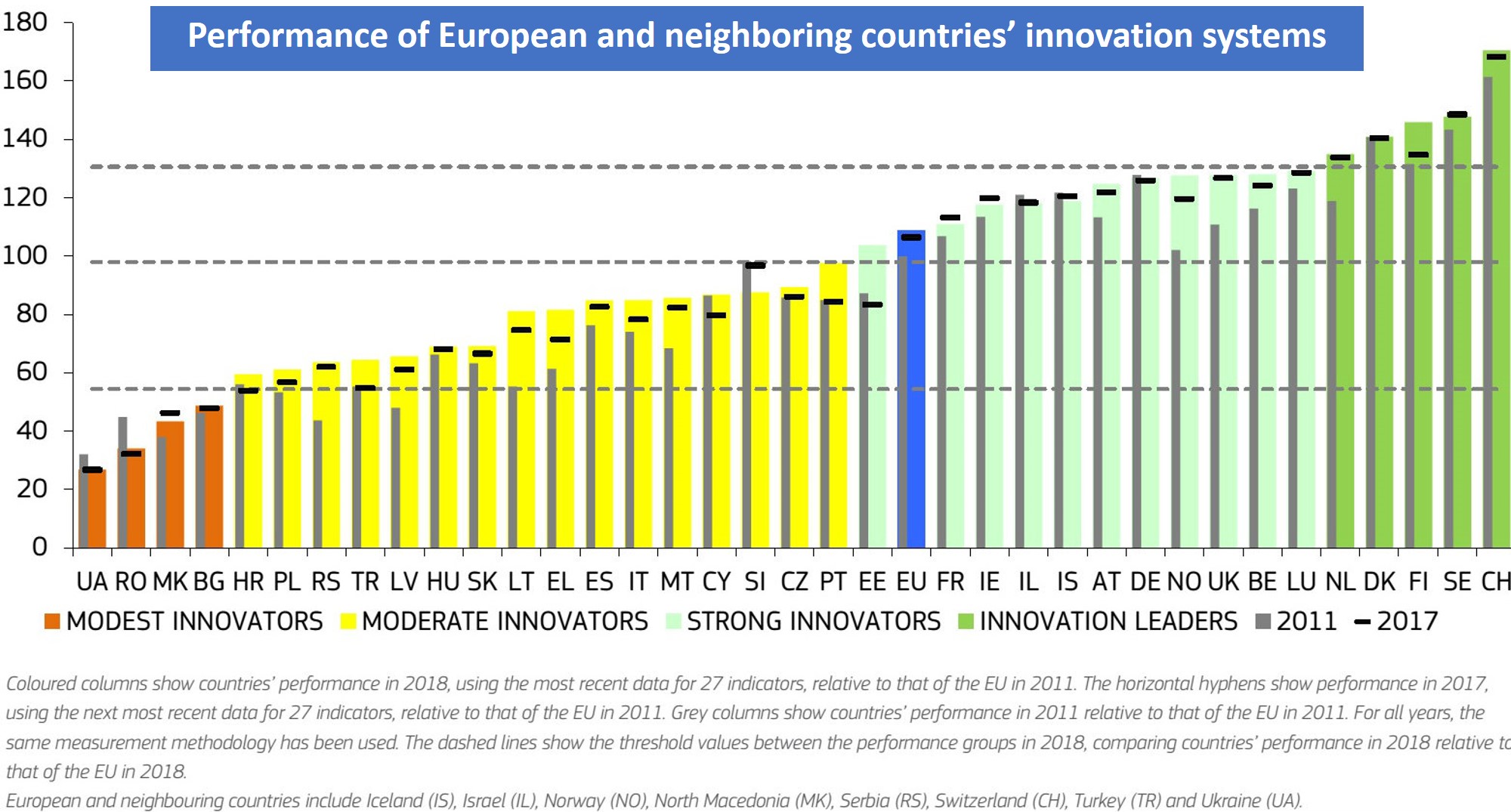Tydzień w gospodarce
Category: Trendy gospodarcze
This year’s European Innovation Scoreboard shows that the EU’s innovation performance is getting better at a steady pace. It has been improving for four years in a row. At the global level, the EU is behind South Korea, Canada, Australia and Japan, but, compared to the last year, it is more innovative than the United States. The gap between the EU and Japan and South Korea is increasing. Authors of the report predict that this trend will continue in coming years. The EU has improved its position when compared not only to the US but also to Australia and Canada. China is catching up at two times the EU’s innovation performance growth rate.

The EIS distinguishes between four main types of indicators — Framework conditions, Investments, Innovation activities, and Impacts — and ten innovation dimensions, capturing in total 27 different indicators.
Based on their average performance scores, as calculated by a composite indicator, the Summary Innovation Index, Member States fall into four different performance groups:
In this year’s edition, Estonia (previously a Moderate Innovator) joins the group of Strong Innovators. Luxembourg and the United Kingdom (both previously Innovation Leaders) drop to the group of Strong Innovators, and Slovenia (previously a Strong Innovator) drops to the group of Moderate Innovators.
For the whole EU, performance between 2011 and 2018 improved by 8.8 percentage points. It improved for 25 Member States and worsened for three Member States:
In previous EIS reports, less innovative countries tended to improve their performance faster than more innovative ones. This year’s report shows that, more recently, the change in performance is not related to the level of innovation. Between 2011 and 2018, there has been a strong convergence in innovation performance between Member States, with lower performing countries, on average, improving their level of innovation performance at a higher rate than higher performing countries. This process of convergence has accelerated in 2018.
EC also had a look at 8 European countries, non-EU members. Switzerland is the overall Innovation Leader in Europe, outperforming all EU Member States. Iceland, Israel, and Norway are Strong Innovators. Serbia and Turkey are Moderate Innovators, and for both countries performance relative to the EU has increased strongly. North Macedonia and Ukraine are Modest Innovators. Performance relative to the EU has increased for North Macedonia but decreased for Ukraine.

Estonian performance has increased relative to that of the EU in 2011. The strong increase in 2018 is largely explained by improved performance on the indicators using CIS data. Intellectual assets, Linkages and Human resources are the strongest innovation dimensions. Estonia scores high on Innovative SMEs collaborating with others, Trademark applications, and Non-R&D innovation expenditures. Sales impacts and Employment impacts are the weakest innovation dimensions. Low-scoring indicators include PCT patent applications, SMEs with marketing or organizational innovations, and R&D expenditures in the business sector.
The second best is the Czech Republic but the country is in a Moderate Innovator group. Employment impacts, Innovators and Firm investments, are the strongest innovation dimensions. Czech Republic scores high on Employment fast-growing enterprises of innovative sectors, Medium and high-tech product exports, and SMEs innovating in-house. Finance and support, Intellectual assets and Attractive research systems, are the weakest innovation dimensions. Low-scoring indicators include Venture capital expenditures, PCT patent applications, and Most cited publications.
Slovenia is the third within the CSE countries, as a Moderate Innovator. Its innovation performance decreased in 2018. This drop is explained by worsened performance for New doctorate graduates and the indicators using CIS data. Firm investments, Human resources and Linkages, are the strongest innovation dimensions. Slovenia scores high on International scientific co-publications, Enterprises providing ICT training, and Trademark applications. Finance and support, Sales impacts and Innovators are the weakest innovation dimensions. Low-scoring indicators include Venture capital expenditures, Knowledge-intensive services exports, and Foreign doctorate students.
Poland is a Moderate Innovator. Over time, Poland’s performance has increased 7.8 percentage points relative to that of the EU in 2011. Innovation-friendly environment and Employment impacts are the strongest innovation dimensions. Poland scores high on Opportunity driven entrepreneurship, Design applications, and Population with tertiary education. Innovators, Attractive research systems and Linkages are the weakest innovation dimensions. Low-scoring indicators include SMEs with marketing or organization innovations, Foreign doctorate students, and PCT patent applications.
7 out of 16 regions of Poland are Moderate Innovators, with Warsaw (the capital) being Moderate+. Over the years 2011-2019 the highest growth was in Małopolskie region (16.7 per cent) and Podkarpackie (14 per cent) — both located in southern Poland. The rest of Poland is in “Modest Innovator” group. In all three regions number of people with tertiary education is well above the EU average.
There are two the least innovative countries — Bulgaria and Romania, both in the group of the Modest Innovator. Over time, Bulgaria’s performance has increased relative to that of the EU in 2011. Employment impacts and Intellectual assets are the strongest innovation dimensions. Employment fast-growing enterprises of innovative sectors, Design applications, and Trademark applications, score relatively high above the EU average. Finance and support, Attractive research systems and Innovators, are the weakest innovation dimensions. Bulgaria’s lowest indicator scores are on R&D expenditure in the public sector, Most cited publications, and Lifelong learning.
In the years 2011-2018, Romanian performance has declined the most (-10.7 percentage points), but after a strong decline between 2011 and 2015, performance has started to increase after 2015. Innovation-friendly environment and Sales impacts are the strongest innovation dimensions. Broadband penetration scores high above the EU average, Medium and high-tech product exports is the only other indicator showing above EU average performance. Innovators, Firm investments and Human resources, are the weakest innovation dimensions. Romania’s lowest indicator scores are on Lifelong learning, SMEs with product or process innovations, SMEs with marketing or organizational innovations, and SMEs innovating in-house.
The analysis suggests that EU innovation performance will continue to increase for most indicators, leading to an increase in overall EU innovation performance compared to 2011, from 109 in 2018 to 114 in two years’ time. EC stressed that it’s time to turn Europe’s excellence in science into cutting-edge technology and innovation. Innovation is needed to support sustainable growth and maintain a globally competitive industry.
This is why the EU has to prioritize research, innovation and investment. Within the next budget EUR100bn should be spend on research and innovation program “Horizon Europe”. It will promote innovation by identifying ground-breaking ideas and making them scale up and open up new markets.
“The European Innovation Council will provide financing for high-risk and breakthrough innovations to help them get to the stage where private financing kicks in. EU cohesion policy funds will be another essential instrument to unleash innovation in all regions of Europe. Other programs such as the EU Space Program, the European Defense Fund, the Digital Europe Program will be key to boost also investment in key strategic technologies,” wrote in the foreword to the report Elżbieta Bieńkowska, European Commissioner for Internal Market, Industry, Entrepreneurship and SMEs, and Carlos Moedas European Commissioner for Research, Science and Innovation. They also stressed that the EU will continue to improve how the EU Single Market works creating a launch pad for our innovative companies.


